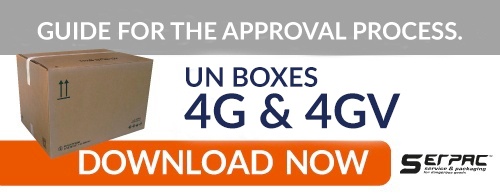Packages, containers and vehicles: which labels to apply when transporting dangerous goods

Among the main requirements regarding the transport of dangerous goods, one of the most important is correct signalling of their presence and the nature of the related danger.
ADR, RID, ADN, IMDG and ICAO / IATA regulations, each for a different mode of transport, have focused greatly on this aspect and require the inclusion of signalling elements on containers such as labels, marks, panels and plates to accompany the products along their way, from departure to arrival.
Do you know how to prepare your packaging in compliance with regulations?
Find out how by downloading our guide on UN 4G and 4GV boxes for free!
The main characteristics of signs include visibility, resistance to the elements, and being made according to definite specifications.
Labeling is a delicate matter, so much so, that those involved in the transport of dangerous goods must master and manage it correctly, either in person or with the help of a specialist.
The subject, is in fact, not without its difficulties: for example: depending on the mode of transport, some aspects (such as the minimum size of the orange panels for shipments by sea) may vary,as well as differences when labeling packages, containers and vehicles.
Let's consider the main ones.
Labeling packages
A package is defined as the final product of the packaging operation, consisting of a packaging or large packaging or IBC, together with its contents, which is ready to be transported. Gas canisters are included in the definition, as well as objects which due to their size, mass or configuration, can be transported in the absence of packaging, either by being tied down, boxed or along with handling equipment.
Labels and marks on packages must have a minimum size of 100x100mm. However, this format can be reduced if the size of the package requires it, provided visibility is preserved.
Labeling containers
A container is a transport device, consisting of a frame or similar construction, of a permanent character and resistant enough for repeated use. The idea of creating large multi-purpose containers suitable for the transport of goods dates back to 1956 and is thanks to the American entrepreneur Malcom Mclean.
Since then, much has been done, and today’s containers - widely used for the transport of dangerous goods - also include elements that facilitate storage and handling, especially when transhipment from one vehicle to another.
Naturally, the plates and the marks to be used on containers must be clearly visible: this explains the minimum sizes of 250x250mm, much larger than those foreseen for packages.
Even the well-known orange hazard panels which must be placed on transport units carrying dangerous goods have to be clearly visible. For containers, the size of the orange number panels, as required by ADR, RID, ADN regulations, is 400x300mm, with a black border of 15 mm.
For shipments by sea, subject to the IMDG regulations however, the minimum size required is always 300x120mm, with the black border of 10mm.
For 400x300 (ADR, RID and ADN) orange number panels, the first number is on the top half while the second is on the bottom, both divided by a black line. The number on top is also known as the Kemler number and identifies the danger (e.g. hazardous, explosive). The bottom number identifies the goods (e.g. diesel, petrol), and is also called the UN number. In both cases they have a height of 100mm. For 300x120 (IMDG) orange number panels, only the UN number that identifies the goods (e.g. paints, perfumes) is indicated, and in these cases, the digits have a minimum height of 65 mm.
To get an idea of the importance of numbered panels, consider what happens in the event of an accident. Communicating to the fire-fighters the numbers shown on the panel is vital in helping them to establish the best way to act and with the utmost speed.
How do you deal with different types of dangerous goods being transported at the same time? To be in compliance, you need orange number panels for each of the dangerous goods being transported, except in specific circumstances.
Labeling vehicles
Just like containers, for motorized transport units or towed vehicles, the plates and panels must have a minimum size of 250x250mm, ensuring their legibility from a distance.
Depending on the case, in addition to the orange number panels with a minimum size of 400x300mm (the same as for containers), orange generic panels, without numbers may be required. These have the task of providing a general danger warning, and their sizes are the same: 400x300mm or, in special circumstances, 300x120mm.
Proper labeling of packages, containers and vehicles should never be considered simply a requirement. The correct and transparent declaration of the contents to be shipped shown by the labels, favours the safe transportation of dangerous goods, and makes economic exchanges more efficient.
